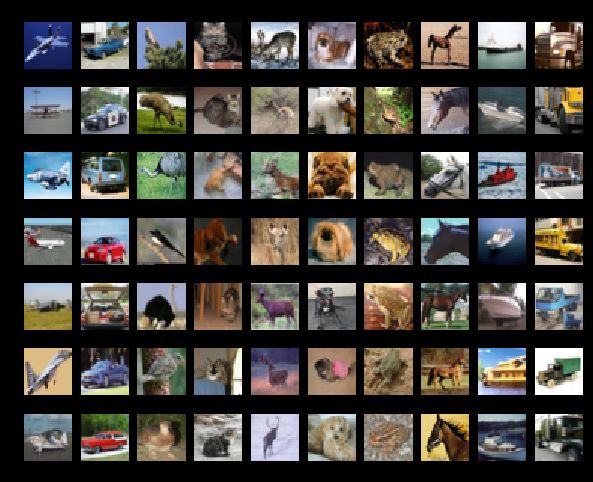CS231n课程学习笔记(一)——KNN的实现
翻译笔记:https://zhuanlan.zhihu.com/p/21930884?refer=intelligentunit
作业讲解视频:http://www.mooc.ai/open/course/364
作业讲解
KNN的实现主要分为两步:
- 训练:分类器简单地记住所有的数据
- 测试:测试数据分别和所有训练数据计算距离,选取k个最近的训练样本的label,通过投票(vote)获得预测值。
在cs231n\classifiers文件夹中的 k_nearest_neighbor.py 完成KNN的实现代码
双循环
每个测试数据和每个训练数据分别计算(两层循环),可以直接使用numpy中一个函数:np.linalg.norm()
for i in range(num_test):#测试样本的循环
for j in range(num_train):#训练样本的循环
#dists[i,j]=np.sqrt(np.sum(np.square(self.X_train[j,:]-X[i,:])))
dists[i,j]=np.linalg.norm(X[i]-self.X_train[j]) 单循环
每个测试数据和训练数据分别整体进行计算(一层循环),使用np.linalg.norm(),注意参数axis的设置(由于我们是在第一维求距离,因此axis=1)。
这里其实使用了广播机制broadcast,
X[i,:]维度为1×D,X_train[i,:]维度为 num_train×D,由于广播机制,X[i,:]会被补为 num_train×D,再使其与X_train[i,:]进行运算,最终dist[i,:]维度为1×num_train。
代码如下:
for i in range(num_test):
#dists[i,:] = np.sqrt(np.sum(np.square(self.X_train-X[i,:]),axis = 1))
dists[i,:]=np.linalg.norm(X[i,:]-self.X_train[:],axis=1)无循环
- 令测试集为 P(m×d) P ( m × d ) ,训练集为 C(n×d) C ( n × d ) , m m 为测试数据数据量, n n 为训练数据数据量, d d 是维度。实际上最后距离公式变为如下形式,注意 PCT P C T 是矩阵乘(
np.dot())。这里实现的依然是广播,所以只要 P P 的形状为 m×1 m × 1 , C C 的形状为 1×n 1 × n 即可。
- 广播: (m,1) ( m , 1 ) (1,n) ( 1 , n ) ⇒ ⇒ (m,n) ( m , n )
具体实现代码如下:
"""
mul1 = np.multiply(np.dot(X,self.X_train.T),-2)
sq1 = np.sum(np.square(X),axis=1,keepdims = True)
sq2 = np.sum(np.square(self.X_train),axis=1)
dists = mul1+sq1+sq2
dists = np.sqrt(dists)
"""
dists += np.sum(np.multiply(X,X),axis=1,keepdims = True).reshape(num_test,1)
dists += np.sum(np.multiply(self.X_train,self.X_train),axis=1,keepdims = True).reshape(1,num_train)
dists += -2*np.dot(X,self.X_train.T)
dists = np.sqrt(dists) 预测
np.argsort() 可以对dists 进行排序选出k个最近的训练样本的下标
np.bincount() 会统计输入数组出现的频数,返回的也是下标,结合np.argmax()就可以实现vote机制。
for i in range(num_test):
closest_y = []
closest_y = self.y_train[np.argsort(dists[i, :])[:k]].flatten()
c = Counter(closest_y)
y_pred[i]=c.most_common(1)[0][0]
"""
closest_y=self.y_train[np.argsort(dists[i, :])[:k]]
y_pred[i] = np.argmax(np.bincount(closest_y))
"""由于我使用np.bincount()时会报错 object too deep for desired array,因此改为上面的代码。(错误原因还未找到……)
Nearest Neighbor 分类器的优劣
该分类器在训练阶段不需要花时间,然而在测试阶段却要花费大量时间,因为要将每一个测试图片与所有训练图片比对。所以几乎没人用这个算法
L1,L2 范数来进行像素比较是不够的,图像更多的是按背景和颜色被分类,而不是语义主体分身
如果想要使K-NN算法实用,可以对数据特征进行normalize,让其均值为0,和单位方差。或者用PCA降维
总体代码展示
由于原代码是python2环境下编译的,而我的编译环境是python3,难免会出现报错,只要将python3的用法替换过去就行了。
打开knn.ipynb
import random
import numpy as np
from cs231n.data_utils import load_CIFAR10
import matplotlib.pyplot as plt
plt.rcParams['figure.figsize'] = (10.0, 8.0) # set default size of plots
plt.rcParams['image.interpolation'] = 'nearest'
plt.rcParams['image.cmap'] = 'gray'
将 data_utils.py 中 import cPickle as pickle 改为 import pickle as pickle
读取数据
# Load the raw CIFAR-10 data.
cifar10_dir = 'cs231n/datasets/cifar-10-batches-py'
X_train, y_train, X_test, y_test = load_CIFAR10(cifar10_dir)
# As a sanity check, we print out the size of the training and test data.
print ('Training data shape: ', X_train.shape)
print ('Training labels shape: ', y_train.shape)
print ('Test data shape: ', X_test.shape)
print ('Test labels shape: ', y_test.shape)- Error:’ascii’ codec can’t decode byte 0x8b in position 6
将 data_utils.py 中datadict = pickle.load(f)改为datadict = pickle.load(f,encoding='iso-8859-1')
OUTPUT:
Training data shape: (50000, 32, 32, 3)
Training labels shape: (50000,)
Test data shape: (10000, 32, 32, 3)
Test labels shape: (10000,)
显示样本
# Visualize some examples from the dataset.
# We show a few examples of training images from each class.
classes = ['plane', 'car', 'bird', 'cat', 'deer', 'dog', 'frog', 'horse', 'ship', 'truck']
num_classes = len(classes)
samples_per_class = 7
for y, cls in enumerate(classes):
idxs = np.flatnonzero(y_train == y)
idxs = np.random.choice(idxs, samples_per_class, replace=False)
for i, idx in enumerate(idxs):
plt_idx = i * num_classes + y + 1
plt.subplot(samples_per_class, num_classes, plt_idx)
plt.imshow(X_train[idx].astype('uint8'))
plt.axis('off')
if i == 0:
plt.title(cls)
plt.show()OUTPUT:
numpy.flatnonzero():
该函数输入一个矩阵,返回扁平化后矩阵中非零元素的位置(index)
enumerate()
返回一个可迭代对象的枚举形式,(上面第一个 返回 0 plane/ 1 car/ 2 bird/……)
调整数据集大小
# Subsample the data for more efficient code execution in this exercise
num_training = 5000
mask = range(num_training)
X_train = X_train[mask]
y_train = y_train[mask]
num_test = 500
mask = range(num_test)
X_test = X_test[mask]
y_test = y_test[mask]
# 把一张图片变为一行向量
X_train = np.reshape(X_train, (X_train.shape[0], -1))
X_test = np.reshape(X_test, (X_test.shape[0], -1))
print(X_train.shape, X_test.shape)OUTPUT:(5000, 3072) (500, 3072)
KNN模型实现
在cs231n\classifiers文件夹中的 k_nearest_neighbor.py 完成KNN的实现代码。
由于每一个图片用一行数据来表示,要得到测试图片 j 与训练图片 i 的L2距离:
只需要将测试数据矩阵第 j 行的每一个点与训练数据矩阵 第 i 行的每一个点平方求和再开方:
dist[i,j]=np.sqrt(np.sum(np.square(self.X_train[j,:]-X_test[i,:])))具体如下:
import numpy as np
from collections import Counter
class KNearestNeighbor(object):
""" a kNN classifier with L2 distance """
def __init__(self):
pass
def train(self, X, y):
self.X_train = X
self.y_train = y
def predict(self, X, k=1, num_loops=0):
if num_loops == 0:
dists = self.compute_distances_no_loops(X)
elif num_loops == 1:
dists = self.compute_distances_one_loop(X)
elif num_loops == 2:
dists = self.compute_distances_two_loops(X)
else:
raise ValueError('Invalid value %d for num_loops' % num_loops)
return self.predict_labels(dists, k=k)
def compute_distances_two_loops(self, X):
num_test = X.shape[0]
num_train = self.X_train.shape[0]
dists = np.zeros((num_test, num_train))
for i in range(num_test):#测试样本的循环
for j in range(num_train):#训练样本的循环
#dists[i,j]=np.sqrt(np.sum(np.square(self.X_train[j,:]-X[i,:])))
dists[i,j]=np.linalg.norm(X[i]-self.X_train[j])
#np.square是针对每个元素的平方方法
return dists
def compute_distances_one_loop(self, X):
num_test = X.shape[0]
num_train = self.X_train.shape[0]
dists = np.zeros((num_test, num_train))
for i in range(num_test):
#dists[i,:] = np.sqrt(np.sum(np.square(self.X_train-X[i,:]),axis = 1))
dists[i,:]=np.linalg.norm(X[i,:]-self.X_train[:],axis=1)
return dists
def compute_distances_no_loops(self, X):
num_test = X.shape[0]
num_train = self.X_train.shape[0]
dists = np.zeros((num_test, num_train))
"""
mul1 = np.multiply(np.dot(X,self.X_train.T),-2)
sq1 = np.sum(np.square(X),axis=1,keepdims = True)
sq2 = np.sum(np.square(self.X_train),axis=1)
dists = mul1+sq1+sq2
dists = np.sqrt(dists)
"""
dists += np.sum(np.multiply(X,X),axis=1,keepdims = True).reshape(num_test,1)
dists += np.sum(np.multiply(self.X_train,self.X_train),axis=1,keepdims = True).reshape(1,num_train)
dists += -2*np.dot(X,self.X_train.T)
dists = np.sqrt(dists)
return dists
def predict_labels(self, dists, k=1):
num_test = dists.shape[0]
y_pred = np.zeros(num_test)
for i in range(num_test):
closest_y = []
closest_y = self.y_train[np.argsort(dists[i, :])[:k]].flatten()
c = Counter(closest_y)
y_pred[i]=c.most_common(1)[0][0]
"""
closest_y=self.y_train[np.argsort(dists[i, :])[:k]]
y_pred[i] = np.argmax(np.bincount(closest_y))
"""
return y_prednumpy.bincount详见这里
训练模型
knn.ipynb:导入KNN模型
from cs231n.classifiers import KNearestNeighbor
classifier = KNearestNeighbor()
classifier.train(X_train, y_train)
dists = classifier.compute_distances_two_loops(X_test)
print (dists.shape) #>> (500,5000)
y_test_pred = classifier.predict_labels(dists, k=1)
#计算两层循环的结果
num_correct = np.sum(y_test_pred == y_test)
accuracy = float(num_correct) / num_test
print ('Got %d / %d correct => accuracy: %f' % (num_correct, num_test, accuracy))
#>>Got 137 / 500 correct => accuracy: 0.274000
#计算一层循环的结果
y_test_pred = classifier.predict_labels(dists, k=5)
num_correct = np.sum(y_test_pred == y_test)
accuracy = float(num_correct) / num_test
print ('Got %d / %d correct => accuracy: %f' % (num_correct, num_test, accuracy))
#>>Got 139 / 500 correct => accuracy: 0.278000
dists_one = classifier.compute_distances_one_loop(X_test)
#检查两次距离是否一样 dists,dists_one
difference = np.linalg.norm(dists - dists_one, ord='fro')
print ('Difference was: %f' % (difference, ))
if difference < 0.001:
print ('Good! The distance matrices are the same')
else:
print ('Uh-oh! The distance matrices are different')
dists_two = classifier.compute_distances_no_loops(X_test)
#检查两次距离是否一样 dists,dists_two
difference = np.linalg.norm(dists - dists_two, ord='fro')
print ('Difference was: %f' % (difference, ))
if difference < 0.001:
print ('Good! The distance matrices are the same')
else:
print ('Uh-oh! The distance matrices are different')计算花费的时间
# Let's compare how fast the implementations are
def time_function(f, *args):
"""
Call a function f with args and return the time (in seconds) that it took to execute.
"""
import time
tic = time.time()
f(*args)
toc = time.time()
return toc - tic
two_loop_time = time_function(classifier.compute_distances_two_loops, X_test)
print ('Two loop version took %f seconds' % two_loop_time)
one_loop_time = time_function(classifier.compute_distances_one_loop, X_test)
print ('One loop version took %f seconds' % one_loop_time)
no_loop_time = time_function(classifier.compute_distances_no_loops, X_test)
print ('No loop version took %f seconds' % no_loop_time)OUTPUT:
Two loop version took 54.055462 seconds
One loop version took 125.000361 seconds
No loop version took 0.686570 seconds
利用Cross-validation选择K值
超参数 hyperparameter
机器学习算法设计中,如K-NN中的k的取值,以及计算像素差异时使用的距离公式,都是超参数,而调参更是机器学习中不可或缺的一步。
注意:调参要用validation set,而不是test set. 机器学习算法中,测试集只能被用作最后测试,得出结论,如果之前用了,就会出现过拟合的情况
交叉验证cross validation set
这是当训练集数量较小的时候,可以将训练集平分成几份,然后循环取出一份当做validation set 然后把每次结果最后取平均。如下:
将训练集分为如下几部分:
num_folds = 5
k_choices = [1, 3, 5, 8, 10, 12, 15, 20, 50, 100]
X_train_folds = []
y_train_folds = []
X_train_folds = np.array_split(X_train, num_folds)
y_train_folds = np.array_split(y_train, num_folds)
k_to_accuracies = {}
for k in k_choices:
k_to_accuracies[k] = np.zeros(num_folds)
for i in range(num_folds):
Xtr = np.array(X_train_folds[:i] + X_train_folds[i+1:])
ytr = np.array(y_train_folds[:i] + y_train_folds[i+1:])
Xte = np.array(X_train_folds[i])
yte = np.array(y_train_folds[i])
Xtr = np.reshape(Xtr, (X_train.shape[0] * 4 / 5, -1))
ytr = np.reshape(ytr, (y_train.shape[0] * 4 / 5, -1))
Xte = np.reshape(Xte, (X_train.shape[0] / 5, -1))
yte = np.reshape(yte, (y_train.shape[0] / 5, -1))
classifier.train(Xtr, ytr)
yte_pred = classifier.predict(Xte, k)
yte_pred = np.reshape(yte_pred, (yte_pred.shape[0], -1))
num_correct = np.sum(yte_pred == yte)
accuracy = float(num_correct) / len(yte)
k_to_accuracies[k][i] = accuracy
# Print out the computed accuracies
for k in sorted(k_to_accuracies):
for accuracy in k_to_accuracies[k]:
print ('k = %d, accuracy = %f' % (k, accuracy))OUTPUT:
k = 1, accuracy = 0.263000
k = 1, accuracy = 0.257000
k = 1, accuracy = 0.264000
k = 1, accuracy = 0.278000
k = 1, accuracy = 0.266000
k = 3, accuracy = 0.241000
k = 3, accuracy = 0.249000
k = 3, accuracy = 0.243000
k = 3, accuracy = 0.273000
k = 3, accuracy = 0.264000
k = 5, accuracy = 0.258000
k = 5, accuracy = 0.273000
k = 5, accuracy = 0.281000
k = 5, accuracy = 0.290000
k = 5, accuracy = 0.272000
k = 8, accuracy = 0.263000
k = 8, accuracy = 0.288000
k = 8, accuracy = 0.278000
k = 8, accuracy = 0.285000
k = 8, accuracy = 0.277000
k = 10, accuracy = 0.265000
k = 10, accuracy = 0.296000
k = 10, accuracy = 0.278000
k = 10, accuracy = 0.284000
k = 10, accuracy = 0.286000
k = 12, accuracy = 0.260000
k = 12, accuracy = 0.294000
k = 12, accuracy = 0.281000
k = 12, accuracy = 0.282000
k = 12, accuracy = 0.281000
k = 15, accuracy = 0.255000
k = 15, accuracy = 0.290000
k = 15, accuracy = 0.281000
k = 15, accuracy = 0.281000
k = 15, accuracy = 0.276000
k = 20, accuracy = 0.270000
k = 20, accuracy = 0.281000
k = 20, accuracy = 0.280000
k = 20, accuracy = 0.282000
k = 20, accuracy = 0.284000
k = 50, accuracy = 0.271000
k = 50, accuracy = 0.288000
k = 50, accuracy = 0.278000
k = 50, accuracy = 0.269000
k = 50, accuracy = 0.266000
k = 100, accuracy = 0.256000
k = 100, accuracy = 0.270000
k = 100, accuracy = 0.263000
k = 100, accuracy = 0.256000
k = 100, accuracy = 0.263000
# plot the raw observations
for k in k_choices:
accuracies = k_to_accuracies[k]
plt.scatter([k] * len(accuracies), accuracies)
# plot the trend line with error bars that correspond to standard deviation
accuracies_mean = np.array([np.mean(v) for k,v in sorted(k_to_accuracies.items())])
accuracies_std = np.array([np.std(v) for k,v in sorted(k_to_accuracies.items())])
plt.errorbar(k_choices, accuracies_mean, yerr=accuracies_std)
plt.title('Cross-validation on k')
plt.xlabel('k')
plt.ylabel('Cross-validation accuracy')
plt.show()OUTPUT:
基于交叉验证集选出合适的K值
# Based on the cross-validation results above, choose the best value for k,
# retrain the classifier using all the training data, and test it on the test
# data. You should be able to get above 28% accuracy on the test data.
best_k = 5
classifier = KNearestNeighbor()
classifier.train(X_train, y_train)
y_test_pred = classifier.predict(X_test, k=best_k)
# Compute and display the accuracy
num_correct = np.sum(y_test_pred == y_test)
accuracy = float(num_correct) / num_test
print ('Got %d / %d correct => accuracy: %f' % (num_correct, num_test, accuracy))
#>>Got 142 / 500 correct => accuracy: 0.284000




